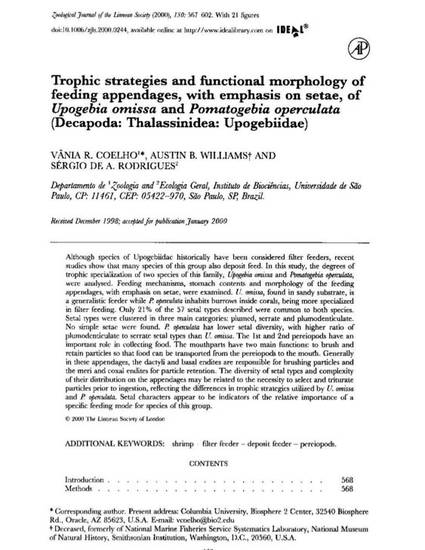
Article
Trophic strategies and functional morphology of feeding appendages, with emphasis on setae, of Upogebia omissa and Pomatogebia operculata
Zoological Journal of the Linnean Society
(2000)
Abstract
Although species of Upogebiidae historically have been considered filter feeders, recent studies show that many species of this group also deposit feed. In this study, the degrees of trophic specialization of two species of this family, Upogebia omissa and Pomatogebia operculata, were analysed. Feeding mechanisms, stomach contents and morphology of the feeding appendages, with emphasis on setae, were examined. U. omissa, found in sandy substrate, is a generalistic feeder while P. operculata inhabits burrows inside corals, being more specialized in filter feeding. Only 21% of the 57 setal types described were common to both species. Setal types were clustered in three main categories: plumed, serrate and plumodenticulate. No simple setae were found. P. operculata has lower setal diversity, with higher ratio of plumodenticulate to serrate setal types than U. omissa. The 1st and 2nd pereiopods have an important role in collecting food. The mouthparts have two main functions: to brush and retain particles so that food can be transported from the pereiopods to the mouth. Generally in these appendages, the dactyli and basal endites are responsible for brushing particles and the meri and coxal endites for particle retention. The diversity of setal types and complexity of their distribution on the appendages may be related to the necessity to select and triturate particles prior to ingestion, reflecting the differences in trophic strategies utilized by U. omissa and P. operculata. Setal characters appear to be indicators of the relative importance of a specific feeding mode for species of this group.
Keywords
- Shrimp,
- Pereiopods,
- Deposit Feeder
Disciplines
Publication Date
December, 2000
Citation Information
Vânia R. Coelho, Austin B. Williams and Sergio de A. Rodrigues. "Trophic strategies and functional morphology of feeding appendages, with emphasis on setae, of Upogebia omissa and Pomatogebia operculata" Zoological Journal of the Linnean Society Vol. 130 Iss. 4 (2000) p. 567 - 602 ISSN: 0024-4082 Available at: http://works.bepress.com/vania-coelho/9/
